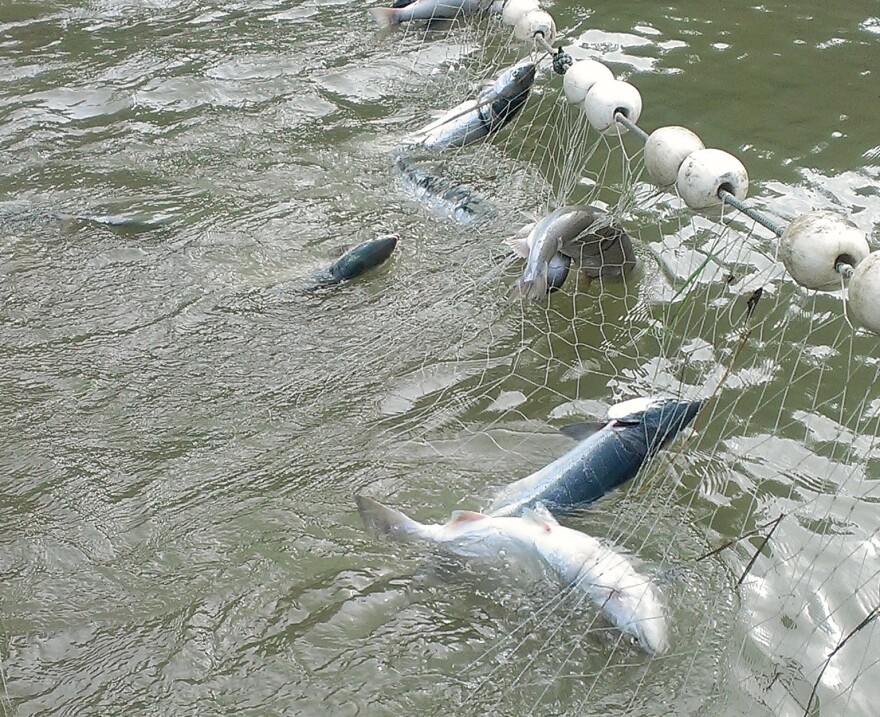Combined, Bristol Bay's 14 major processors say they want to buy 2.1 million fish less than the anticipated harvest of 37.6 million. Restrictions?
The Department of Fish and Game produced a processor capacity survey for Bristol Bay’s fishery this year. The Department did so as they’re anticipating a difference between the large forecasted harvest and the amount of fish the Bay’s processors say they can, or want, to buy in 2015.
KDLG’s Dave Bendinger has more:
Find the processor survey here, or through this website.
Audio transcript below ...
The Dept. of Fish and Game doesn’t do a processor capacity survey for Bristol Bay every year anymore. But with this year’s forecast return of 54 million sockeye, and with the third biggest harvest forecast since 1960, the Dept. felt it was prudent to do one ahead of this season.
The Department surveyed the 14 major salmon processors who collectively accounted for 99 percent of sockeye purchased in the Bay last year. Tim Sands is an Area Manager with Fish and Game in Dillingham:
"The survey asked processors, 'how many fish do you want to buy for the year,' and the answer came back at 35.5 million fish, everybody added up," said Sands.
But the forecast is for 37.6 million fish to be harvested, so there’s gap of 2.1 million fish, roughly 6 percent of the anticipated harvest, that the processors already say they won’t be buying. That’s not something anybody’s happy about.
Then there's the second question asked in the survey.
"The daily capacity, what the processors said they could process per day, was 2.5 million fish per day and they could sustain that for approximately 21 days. In theory, that's over 50 million fish," said Sands.
Why processors say they could process more fish, but won’t be, is beyond the purview of Fish and Game's survey.
The daily processing capacity in Bristol Bay has gone up since the last survey in 2011. The Department says that’s on account of Silver Bay’s entrance into the fishery, as well as upgraded equipment and facilities at other processing plants.
There are a lot of variables as to how this big season will play out, and how many fish will go uncaught because there’s no one to buy them. Sands says the biggest factor will be how the fish come in:
"If they all come in in kind of a compressed deal where we're having harvests of over 2.5 million fish for a couple of days, I think that'll really strain capacity."
Then again, if the peak of the run is more spread out, the buyers may be able to keep pace better.
Sands says he’s already planning a more aggressive approach to the beginning of the season, anticipating that the fishing may be slowed around the peak by the buyers, not the Department.
Two more things to keep in mind: last year, processors in the Bay buckled under the strain of the 30.9 million fish harvest, which is seven million less fish than are expected to be harvested this season. And, last year’s run actually came in 53 percent bigger than the preseason forecast. That could of course happen again in 2015 (the range of the total run is actually 44.8 to 63.1 million).
Contact the author at dave@kdlg.org or 907.842.2200.
The survey has other interesting information and commentary, including this: A large projected harvestable surplus can prompt questions about allowing foreign processing vessels into the internal waters of the State of Alaska. While there have been no inquires this year, the Bristol Bay sockeye salmon processing capacity survey is an instrument that can be used to determine whether domestic processors have enough capacity to handle the expected harvest. The Magnuson-Stevens Fishery Conservation and Management Act provides the framework requirements that must be met before foreign processing ships are allowed into the internal waters of the state. The Magnuson-Stevens Fishery Conservation and Management Act requires the governor to determine whether adequate domestic processing capacity exists and whether that capacity will be used to process the available harvest before allowing any foreign processors into state waters (16 U.S.C. § 1821). Should the governor receive a request to bring foreign processing ships into the internal waters of the state to process salmon in Bristol Bay in 2015, information from this survey would be considered by the governor, along with other information, in determining whether foreign vessels should be allowed to enter the internal waters of the State of Alaska to process salmon (16 U.S. Code § 1856(c); 5 AAC 39.198).


